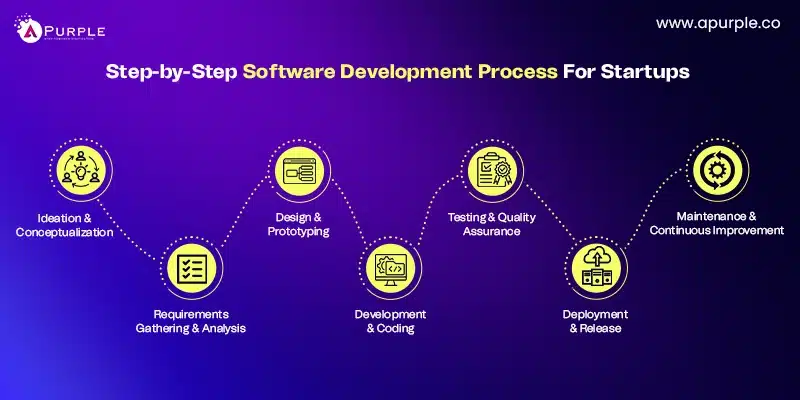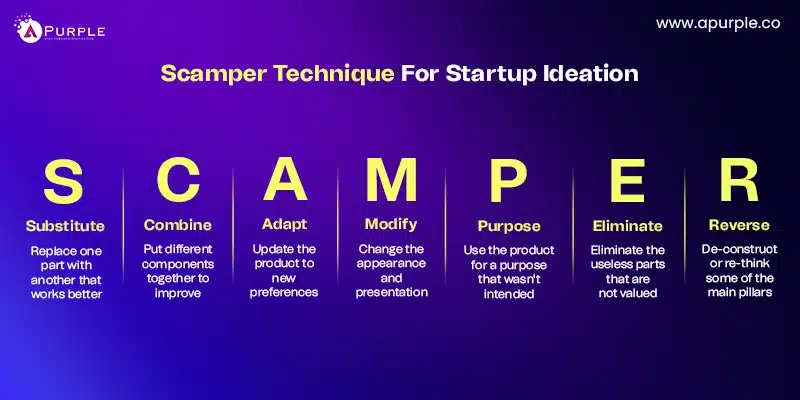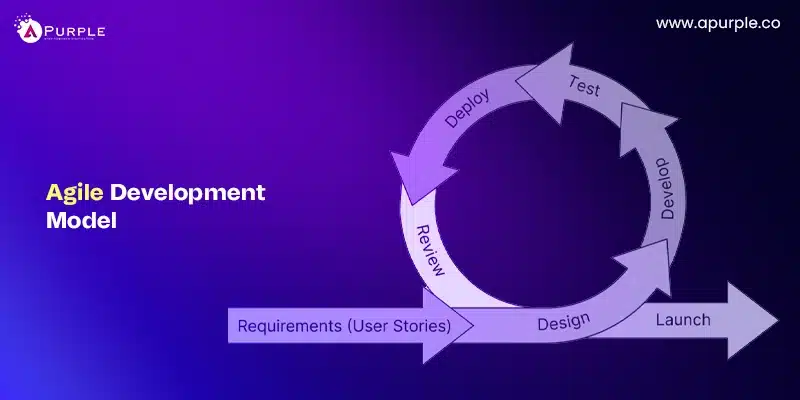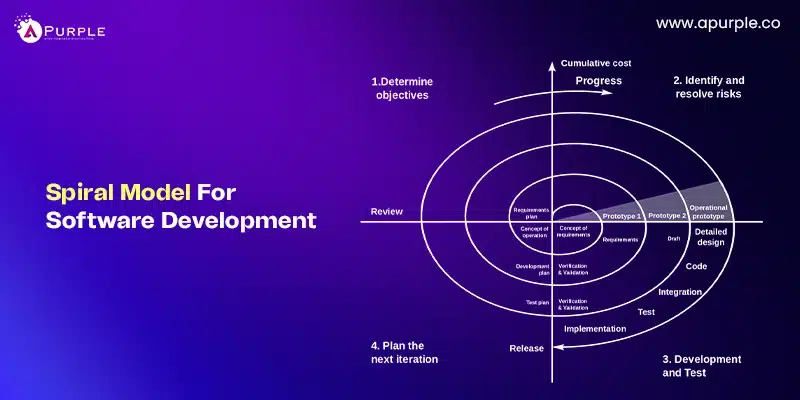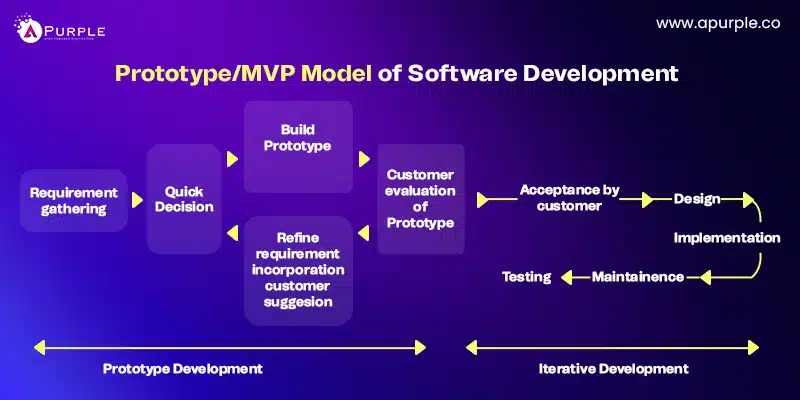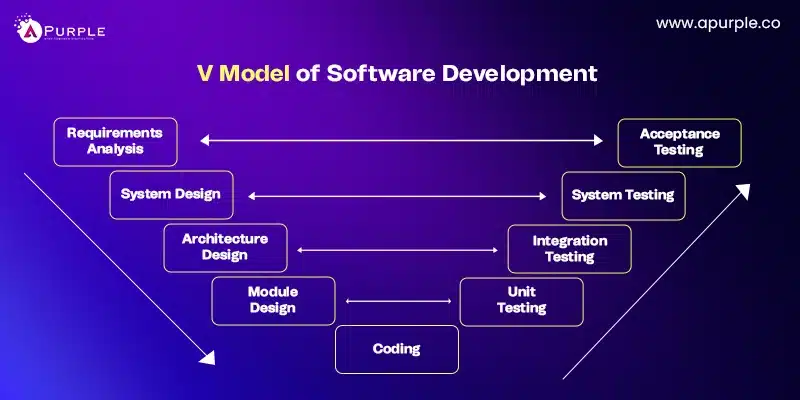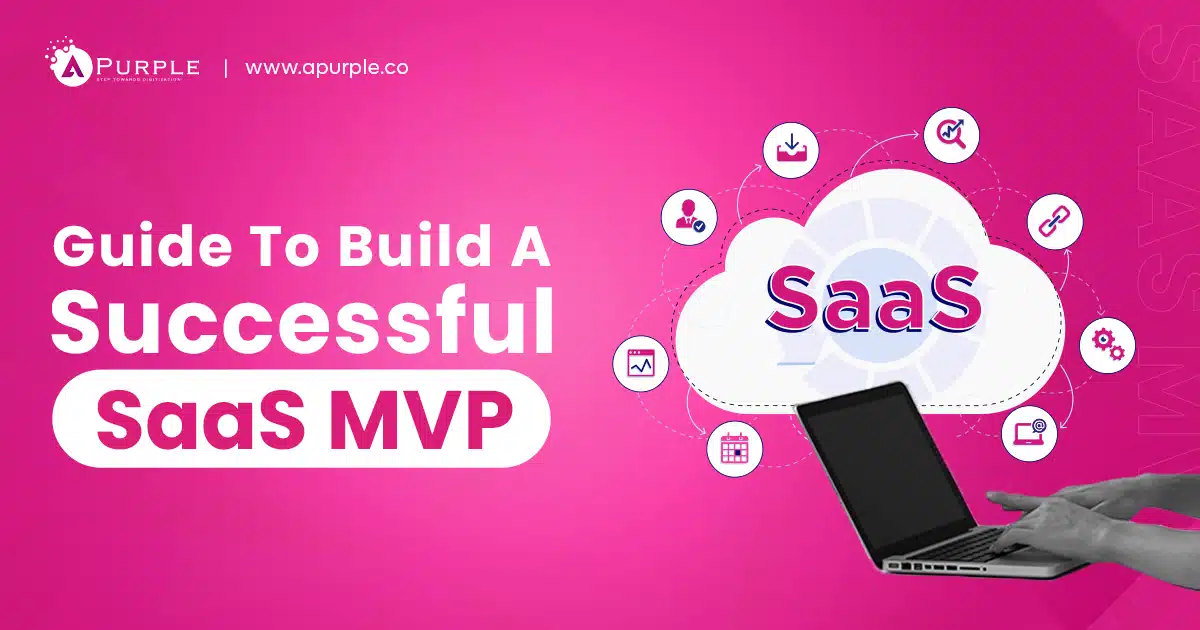
The startup ecosystem is getting exciting, focusing on innovations and deep tech. More startup founders are now grappling with the challenges of raising funds and scaling their businesses, and this is where software development for startups takes center stage.
A TechCrunch report indicates increased chances of a rise in investments for startups with a technical CEO. This shows the importance of software development services for startups looking to raise funds and expand their operations.
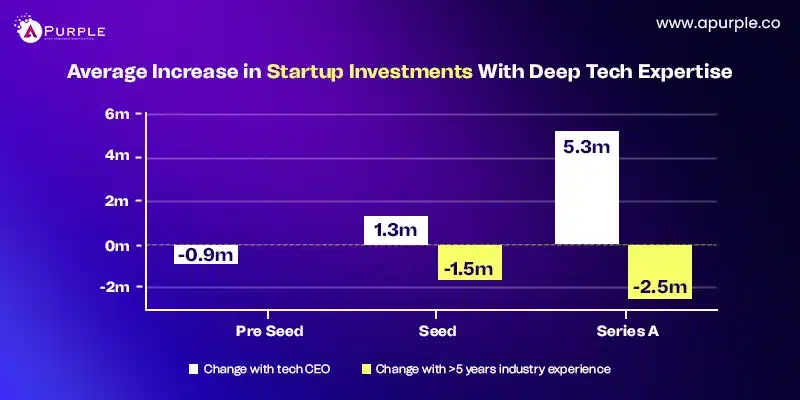
But is that all?
Software development is highly effective whether you are a bootstrapped startup or looking to raise more capital and expand operational capabilities. This article will help you understand why your startup needs software development and the different stages, costs, and tech you need.
But first, here are some significant reasons you need to invest in software development.
Why Should a Startup Invest in Software Development?
Software development is the core of your startup journey, especially with rapid digitalization. So, whatever your idea may be, software development will help you implement it with a digital platform.
Beyond software development as a product, it can also help you streamline operations. Startup software development will allow you to ensure objective alignment across departments. This means all your resources are well-directed towards a common organizational goal. Here are some reasons you need to invest in software development.
1. Everyone Is On The Same Page
When you start your startup journey, the team can be more minor, but as the business grows, it will scale. Maintaining coordination and ensuring timely project completion and performance can be challenging at scale.
Leveraging software development for startups can ensure that every team member is on the same page. It allows you to centralize operations and ensure high-quality delivery.
2. Seamless Growth
Startups’ growth depends not only on high-performance delivery but also on how seamlessly delivered it is. You must scale your team, offerings, and quality without friction.
For example, if you are building the next Instagram, you must scale your infrastructure, teams, and delivery. Focusing on software development for startups can help entrepreneurs ensure a seamless transition from 0 to 100, 100 to 100,000 customers, and beyond.
3. Competitive Edge
Startups thrive in a more competitive market with software development. Using software development services for startups, you can build unique features that set you apart from the competition. Choosing an advanced solution from innovative software development for startups will also open up new avenues for your business.
This means you will have,
- Future-ready software
- Reliable systems
- Secure experiences
- Maintainable code
- Better UX
4. Improved CX
Startups can improve customer experience by providing a user-friendly interface, personalized features, and unique interactions. Your startup can design intuitive interfaces by leveraging custom software development, leading to higher customer satisfaction.
5. Higher Data Security
A significant impact of choosing software development for startups is the security of sensitive data. Software development companies offer solutions with robust encryption, access controls, and regular security updates, which help ensure compliance with industry data protection standards.
Now that you know why investing in software development for startups makes sense, here is how to develop one step-by-step.
Step-by-Step Software Development Process For Startups
The software development process for startups encapsulates several stages, from ideation to deployment and maintenance. Entrepreneurs embark on this journey with a specific set of challenges. A streamlined software development process helps entrepreneurs overcome challenges and improve ROI.
Step 1: Ideation and Conceptualization
The first stage of the software development process for startups is creativity, which involves brainstorming, identifying market gaps, and envisioning a solution. Entrepreneurs must ideate a solution for a specific market problem and research customer pain points. Startup owners can conduct market research in their niche and find existing issues.
Further, entrepreneurs can ideate on solving these problems using ideation techniques. For example, if you are a startup looking to ideate efficiently, you can use the SCAMPER technique. SCAMPER stands for Substitute, Combine, Adapt, Modify, Repurpose, Eliminate and Reverse.
This technique is beneficial in ideating software development ideas for startups looking to solve an existing problem in the market. You can systematically discuss and explore different approaches to solving an existing problem using this technique. You can reimagine existing solutions, modify, adapt, and build new concepts.
Step 2: Requirement Analysis
The second and most significant stage of startup software development is requirement gathering. This stage allows startups to collaborate with stakeholders, potential customers, and domain experts to understand critical requirements.
This stage of startup software development involves conducting surveys, interviews, and workshops to get detailed requirements. Further, the requirements must be scrutinized, and a scope report for the solution must be created. This report will form the basis of your MVP or Minimum Viable Product.
Step 3: Prototyping and Designing
After clarifying the solution’s scope, the first step is to build a shippable product version. This minimal version has essential features and functionalities to capture customer feedback.
Integrate this feedback, creating a better version each time with an iterative process. MVP development for your startup also involves creating a design prototype and wireframe for the entire project.
This includes UX designers creating highly responsive and functional interfaces for your software. Using the MVP, you can validate how functional, usable, and reliable your software is.
Step 4: Coding and Development
The next stage is coding your software and developing the solution. This involves coding, testing, and deploying. The development stage needs a strategic and streamlined process to maximize software performance. This is why partnering with a software development service for startups becomes crucial.
The best approach is to choose software development services for startups with agile expertise. With an iterative process, you can gradually improve your integration of user feedback.
This will involve continuous improvement in your software. Another crucial aspect of the agile approach is constant testing.
Step 5: Testing and QA
This stage of software development for startups encapsulates extensive testing. First, you must identify different test scenarios and build test cases. The output of these tests is thoroughly analyzed, and systems are fine-tuned accordingly.
While this is a resource-intensive activity, you need a strategic blend of manual and automated testing. By leveraging test automation, you can reduce the time to market, cost, and effort required for the testing process.
Step 6: Deployment and Release
Once your software is tested and passes QA assessments, it’s time to deploy. There are two ways to go about the development: going all in or taking a soft-release approach.
A phased approach to releasing the software makes more sense since you are a startup entering the market. Strategic deployment is crucial because you need to consider resources, infrastructure, and security as part of your business scale.
One way to ensure efficiency in deployment is by leveraging continuous integration and delivery. CI/CD implementation and DevOps culture can help you streamline deployments across platforms.
Step 7: Continuous Maintenance
Startups need a continuous mindset because deploying software does not end the development process. Once the software is deployed, continuous maintenance begins.
It involves identifying bugs, addressing them, and ensuring a seamless user experience. To provide better observability, you will need a logging and monitoring system. Continuously measuring and optimizing the app for a better experience will be essential, as will reaching your audience.
Marketing the application will be crucial, whether it’s app store optimization or promoting your startup on multiple channels. This is where branding services for startups come into play. Developing the software product plus proper branding will take your startup to new heights.
Problems & Solutions of Software Development Process
Software startup companies often need help developing reliable products. For example, every startup faces the challenge of taking longer to market.
Similarly, there are challenges in infrastructure, quality assurance, and more. However, the most significant challenge is the need for a clear roadmap.
1. Need for a Comprehensive Roadmap
A startup begins with one idea, but developing that idea into a full-fledged product requires a strategic roadmap. A product roadmap offers startups a plan for developing the software. It helps startups communicate with stakeholders and users and understand their requirements.
Visualizing the roadmap for your product development can help startups better manage priorities and clarify release dates, features, and more. Starting a new task can have a specific set of challenges, and a roadmap provides the structure of processes to overcome these challenges.
So, what’s the main problem here?
Creating a roadmap for a new venture takes work, especially if you are well-versed in the ins and outs of a market. Outsourcing software development for startups helps. It allows entrepreneurs to collaborate with an experienced partner who provides a comprehensive roadmap.
2. Choosing Tech Stack For Startup Project
A crucial decision for any startup is choosing the tech stack for their project. This includes programming languages, frameworks, and tools to help build the digital product. The choice of tech stack affects several activities for your startup. For example, the developers you need will depend on the programming language or framework you choose to build your apps.
The tech stack you choose must align with business objectives. You also need to consider technology obsolescence. Choose a future-proof tech stack, as frameworks and programming languages keep evolving. The best practice is to consult with expert software development companies for startups to ensure an optimal tech stack for your project.
3. Getting An Expert Team Onboard!
Finding the right talent is a significant challenge for any startup owner. Most entrepreneurs need help finding a software developer. You first need to define the hiring requirements and then look for options.
Your team will be crucial to a startup’s success, so choosing suitable candidates becomes quintessential. However, with the increasing skill gap, finding talents has become challenging. A Springboard survey indicates that 70% of market leaders believe a growing skill gap exists.
So, how to find a software developer for a startup?
There are two options that you can choose from!
- Hire an in-house team – “It’s costly, time consuming but offers better control!”
- Outsource it to an expert – “outsourcing software development for startups is less time consuming and cost effective with control over software delivery.”
Outsourcing software development for startups is a better option, given that you are new to the market and want to spend more time developing the product.
4. Focusing on UX/UI
A significant problem with startups is that they focus too much on product marketing but ignore the UX/UI part. Getting the design right is challenging, and many giant companies need to catch up, ignoring the UX/UI at the expense of marketing.
A well-designed startup product can attract users and deliver an experience that retains customers. This means more conversions and sales. For example, if you are developing a web-based software product, the right web design can help attract new customers and boost conversions and sales. Ultimately, you will have the revenue and profits you always planned for.
How do you get the UI/UX right?
The best way to ensure you get the design right is by hiring experts to help you achieve consistency. Ensure you get four designs consistently on point with a software product development company. This will not only allow your software product to offer a unique user experience but also help in increasing brand awareness.
These design consistencies are,
- Visual Consistency includes a consistent set of colors, fonts, margins, padding, and grid systems.
- Functional Consistency ensures that similar actions, such as clicking buttons or navigating a menu, and all the UI components function correctly.
- Internal Consistency is all about ensuring all the components of your product work across platforms.
- External Consistency aligns the design elements with other brand family or startup ecosystem components.
5. Laying the foundation with robust project infrastructure
Startups face the most significant problems when they start a project. Creating a solid foundation and project infrastructure is quite challenging. Some of the significant questions that entrepreneurs have are,
- What should be the size of the product infrastructure?
- How much data will be processed?
- What will be the security measure to secure data?
- How much infrastructure will cost?
Answering these questions can help you optimize infrastructure costs. However, such questions can be challenging for startup owners without technical backgrounds. Fortunately, some service providers in the market, like aPurple, offer efficient software product development for startups.
6. Meeting Dynamic Requirements
Startups face several dynamic requirements during the software development lifecycle(SDLC). Each phase of the SDLC has different requirements, and meeting them without access to flexible talents becomes challenging.
This is where startups can partner with software development services to ensure dynamic resource availability. They are readily available if you need an additional tester, developer, or QA during the development or deployment stage.
Advantages of Software Development Services for Startups
Startups rely on technology to build digital products to engage, interact, and transact with users. This is why hiring software development services for startups becomes essential. Some of the significant advantages of software development services for startups that you can expect are,
1. Customizations That Transform!
Custom software is crafted to address your startup’s necessities and stipulations. Startups cater to specific audiences with unique offerings that require customized solutions.
Acing your custom software development for startups is crucial. The reason is simple: there is high competition in any niche, and to ensure your business stands out, you need targeted customization. Software development for startups provides a high level of customization, ensuring a unique user experience.
2. Scalability and Flexibility
Choosing software development for startups means you, as an entrepreneur, can adapt to dynamic market demands.
Two aspects of software development services for startups make it attractive-
- The ability for startup owners to scale their offerings as per need
- Capability to remove or add resources at will
So, custom software offers scalability advantages, allowing your systems to scale as the user base grows. You can add a developer, designer, tester, or other resource on-demand.
3. Personalized Experiences
Using custom software and app development, you can ensure personalized experiences for your users. For example, if you are building an app like Uber, but users in your region have different ride preferences, you can tweak the app accordingly. Similarly, there are tons of other personalizations that custom solutions can help you implement for your audience.
4. Ease of Integrations
The evolution of technologies over the years has become more demanding. So, as an entrepreneur, you need to ensure your systems are up to date with the latest tech changes. This is where choosing software development for startups becomes advantageous.
It allows startups to integrate innovative technologies on demand. Take an example of the latest innovations in the field of artificial intelligence. Software development solutions enable startups to integrate AI algorithms easily through API-based solutions.
5. System Reliability
Startups need reliable systems to ensure customers have access to their products at all times. However, startups need a strategic software development process to maintain high availability.
The observability advantage of choosing software development for your startup is higher. Observability involves collecting, visualizing, and applying intelligence to predefined metrics, traces, logs, and events. It allows startups to understand the behavior of a complex system.
Observability enables you to understand the reasons behind system issues, ensuring better response time. With an advanced software development service for startups, you can ensure system reliability through enhanced observability.
There are many advantages to choosing software development for startups, but maximizing the potential can only be possible with a structured approach. This is where software development models can help.
5 Models To Choose For Your Software Development Process for Startups
Software development models allow you to create a structured process with a sequence of activities, milestones, and deliverables. They also enable startups to define the direction they want to take with their software development process. Further, software development models ensure optimal resource utilization and minimize risks.
Some of the software development models that you can use are,
1. Waterfall Model
Often considered a conventional approach to software development, this model follows a set sequence of activities. It encapsulates all the stages of SDLC, from requirement analysis to design, implementation, and deployment.
The waterfall software development model offers a linear methodology. Each process stage follows a sequence, which depends on the last stage. This model best suits software product development for startups with well-defined requirements.
Pros
- Simple and easy to use for the team
- Pre-defined stages and deliverables
- Well-maintained documentation
- Offers a structured approach to software development
Cons
- There is no flexibility to adjust changes according to the market
- Feedback integration is minimal
- Longer development cycle that increases costs
- Higher risk of errors in the production stage
Understand the fundamental differences between development methodologies in our complete agile vs waterfall guide.
2. Agile Model
The next best mode to optimize the software development process for a startup is agile. It allows you to divide your project into smaller iterations developed using an incremental approach.
In each iteration, a specific part of your startup software is first developed and tested for bugs. Agile application development also allows you to integrate customer feedback after each iteration, ensuring continuous improvements.
This is crucial for any startup because understanding and integrating feedback during the initial stages of the development process is vital. It allows startups to develop a solution that resonates with the target audience.
For example, if you are developing logistic software, you can develop basic features and then leverage agile to create more advanced features. If you want to create custom algorithms and build an AI in logistics feature, you can incrementally build it while offering the essential features in initial iterations.
Pros
- Allows integration of customer feedback with each iteration
- Reduced time to market with an iterative approach
- Offers greater flexibility in making changes according to the changing market demand
- Reduces the risk by ensuring testing each iteration before the release
Cons
- Needs continuous collaborations between cross-functional teams
- Estimating the timeline and resources can be difficult
3. Spiral Model
The spiral model offers risk management for startups. Its base is an incremental, iterative approach like agile, but it optimizes it by adding risk engineering. The spiral model helps reduce risks with an iterative approach that leverages waterfall and prototyping.
Execution of the spiral model includes four significant activities,
- Risk planning
- Risk analysis
- Prototype creation
- Deliverable evaluation
Risk planning involves assessing and defining each role within the team. After completing the first iteration, the team analyzes performance and gathers user feedback. The identified performance issues are fixed, and feedback is integrated into the next cycle. Testing allows risk management, ensuring no bug or inherent vulnerability goes unnoticed.
Pros
- Risk aversion is possible with this model
- Helps identify sources of risks
- Allows startups to accommodate changes with each iteration
- Enables the startups to switch between methodologies like agile and waterfall
Cons
- Multiple methodologies make the entire process complex
- Requires an experienced team for risk management
4. Prototyping/MVP Model
The prototyping or Minimum Viable Product(MVP) model allows startups to create a shippable version of their product. First, the team makes a small-scale prototype that is scaled gradually. The startup project is executed in stages, allowing teams to integrate the feedback continuously.
Startups further test the prototype based on user feedback until an optimal version is achieved. Developers wait until the final approval for a prototype comes before starting work on the solution. This model also allows startups to add features at any time according to customer demand, making it a viable option for software development projects.
Pros
- Offers early feedback integration
- Allows startups to visualize the entire software working
- Reduces miscommunication between team members
- Startups can implement the fail-fast approach
Cons
- Managing the time of project delivery can be difficult
- Not suitable for large-scale projects
You May Also Like: Build a SaaS MVP for Your Startup
5. V Model
The V model is often considered an extension of the waterfall model. It follows the same sequence until the coding stage, and the process moves upward. This upward movement accounts for the validation stages, and the downward sequence covers the verification stage.
This upward movement from the coding stage forms a V-shape called the “V-Model.” What sets this model apart from the waterfall model is testing at each stage to verify the quality of the software. For a startup, the V model is best for ensuring high-performance products and reducing the risks due to testing after the entire development process.
Pros
- Emphasis on validation and verification ensures high-quality development
- End-to-end documentation and code reviews
- A comprehensive and structured approach to the software development process for startups
Cons
- An unopinionated development approach with the v model can hamper productivity.
- It does not offer flexibility to make changes during the development process.
Using these models, you can improve the speed of your startup software development, reduce time to market, and optimize delivery. However, more than using a software development model is required, as several factors affect the speed of your project.
5 Tips for Fast Software Development for Startups
Startups attempt to address a problem for their niche audience. Often, the decision to start software development for a startup comes at a stage when the market research is completed. This means that the startup has an answer to the problem it wants to solve. However, in most cases, the problem stays elusive.
These issues can increase the time startups need to develop software. Here are some tips to improve the speed of software development for startups.
1. Value Addition
Create a concise plan for your software development project, especially defining the value-adding aspect. This will help ensure that the entire team is on the same page. Here is how you can create a concise plan,
- Define what your startup hopes to achieve from the solution.
- Research the market and understand the current industry
- Develop a business model and revenue streams
- Create a financial plan estimating the cost of the entire project
2. Build Proof of Concepts
Prototypes help startups ensure and reduce risk for startups. The research team of a startup will achieve the goal of identifying, testing, and practically applying a technical solution by creating a prototype in the early phase of the start-up stage.
Startups can quickly get feedback from potential customers and make iterative improvements by creating low-fidelity prototypes. Proof-of-concepts (POCs) share similarities with prototypes, but they demonstrate that the primary function of the product or service is manageable.
Employing POCs, startups can probe critical technical assumptions and spot probable impediments from the very start. These can reduce the time and money wasted.
3. Leverage Agile Development
Agile development methodologies are particularly well-suited for startups. Agile’s iterative, customer-centric nature makes startups more responsive to changing market conditions.
Some key benefits of using agile for startups include:
- Faster time-to-market– Agile’s focus on delivering working software in short sprints means startups can get their product into customers’ hands more quickly.
- Flexibility to pivot– Agile makes it easier for startups to change direction if needed without wasting time and resources.
- Better alignment with customer needs– Continuous customer feedback and collaboration help ensure the product meets user requirements.
- More efficient use of resources– Agile’s emphasis on eliminating waste and optimizing workflows can help startups maximize their limited resources.
4. Automate Tasks That You Can
Automation is critical for startups looking to streamline software development processes. Automating repetitive tasks like testing, deployment, and infrastructure provisioning can save time and effort, allowing the development team to focus on higher-value, strategic work.
Some examples of areas where startups can leverage automation are,
- Automating the build, test, and deployment pipeline ensures new code gets to production quickly and reliably.
- Tools like Terraform and Ansible can automate the creation and management of cloud infrastructure.
- Automated testing suites can catch bugs early and ensure new features don’t break existing functionality.
- Automatically generating documentation from code comments and other sources.
- Keep your codebase clean and maintainable.
5. Keep A Focused Codebase
If you’re a startup, it’s essential to work quickly and introduce new features fast to stay ahead of the competition. But if your software code is too big and over the place, it can slow you down.
Here are some tips to help you keep your software code small and easy to work with,
- If your code is small, it’s easier to handle and understand. This means you can make new things and fix problems faster.
- Instead of trying to make everything, just focus on the most important things that your users need.
- Dividing your code into smaller parts makes it easier to handle and understand. It also makes it easier to use the same code in other projects later on.
- Write code that’s easy to read and understand. This will help you create new things and fix problems faster.
- Make sure your workspace is organized and clean. It helps you work better.
Improving speed is one thing, but keeping the cost minimal and improving speed is another! But to optimize the cost and speed of your software development process, first, you need to understand the different expenses.
Cost Breakdown of Software Development for Startup
As a startup, it’s essential to understand the different factors that influence the overall software development cost. This cost can vary based on the project’s complexity, required features, and the development team’s expertise.
4 Factors Affecting Startup Software Development Costs
1. Project Complexity
The software’s complexity is a significant cost contributor. Software with limited features can cost between $10,000 and $40,000. On the other hand, software with features that are mediumly complex ranges from $45,000 to $60,000. However, highly advanced project costs can soar between $75,000 and $180,000.
| Software Complexity | Description | Cost Range |
|---|---|---|
| Simple/Essential | Limited features and basic functionality. | $10,000−$40,000 |
| Average Complexity | Moderate number of features and complexity. | $45,000−$60,000 |
| Highly Advanced | Large number of advanced features and high complexity. | $75,000−$180,000 |
2. Team Expertise and Location
Estimating the cost of software development products for startups needs skill-based assessment. So, you must gather information on the types of skilled professionals you need for your project.
Plus, you also need to consider the cost difference due to the location of the software development services for startups. This will also solve a significant concern: “How to find a software developer for a startup. ” But before you create an estimation, understanding the difference in hourly charges of hiring developers across locations is essential.
Here is a list of hourly rates worldwide,
| Location | Hourly Rates |
|---|---|
| United States | $53−$130 |
| United Kingdom | $45−$93 |
| Ukraine | $40−$59 |
| India | $18−$38 |
3. Project Timeline
This is the most significant factor impacting software development costs. It is also aligned with the cost of hiring a software developer, which means the price will increase if you hire developers for a project with delays.
So, how much time your startup needs to complete the development process will determine the cost. However, the timeline and budget will be fixed if you opt for a fixed-cost approach while engaging in software development services. This approach is only suitable for small-scale projects with limited scalability.
Flexibility becomes essential to build software for a startup that dynamically integrates features as the market changes. A fixed-cost approach won’t work, so you must accommodate the costs of hiring professionals on demand.
4. Technology Stack
Another significant factor that impacts the cost of software product development for startups is the tech stack. This also includes the cost of maintaining and updating the tech stack at a later stage.
So, startups often choose specific tech stacks for development purposes. The cost of infrastructure, resources, and licensing-specific technology adds to the total expenses. You also need to account for modernizing the tech stack according to changes in the market and customer demand.
According to the factors discussed above, one thing is confirmed: you need the right tech stack that is future-ready and helps optimize costs.
Technologies Used in Software Development
1. Programming Languages
Programming languages are the fundamental building blocks of software development. Some of the most popular programming languages include:
- JavaScript: Widely used for front-end web development, creating dynamic and interactive web pages.
- Python: A versatile, high-level language used for web development, data analysis, machine learning, and more
- Java: A robust, object-oriented language used for enterprise applications, Android app development, and more.
2. Frameworks and Libraries
Frameworks and libraries provide pre-built functionality and structures to speed up development.
- React: A JavaScript library for building user interfaces. It promotes reusable, modular components.
- Angular: A comprehensive TypeScript-based framework for building complex web applications.
- Django: A high-level Python web framework that encourages rapid development of secure and maintainable websites
- NodeJS: A JavaScript runtime environment that allows developers to run JavaScript on the server side.
3. Databases
Software applications require databases to store and manage data efficiently. Popular database technologies include:
- MySQL: A widely-used open-source relational database management system (RDBMS)
- MongoDB: A NoSQL database that handles large volumes of unstructured data.
4. Cloud Computing Platforms
Cloud computing platforms provide on-demand access to computing resources and services, enabling easier and more scalable software development:
- Amazon Web Services (AWS): A comprehensive, leading cloud computing platform
- Microsoft Azure: Microsoft’s cloud platform for building, deploying, and managing applications.
- Google Cloud Platform: Google’s suite of cloud computing services and tools.
How is aPurple the Perfect Software Development Service for Startups?
Market dynamics and the demand for software development services for startups that can meet organizational needs keep changing. Investing in tech enables startups to cope with changing customer demands and gain a competitive edge. However, as a startup, you need more than just off-the-shelf solutions.
You need a custom software development company that offers optimal costs, the required tech stack, and a dedicated team. aPurple is a software development service for startups with an experienced team of skilled professionals delivering dynamic solutions.
With aPurple you get,
- End-to-end startup software development
- A team of experienced developers
- Optimized development cost
- Comprehensive tech support
So, what’s keeping you from creating the next big unicorn? Contact Us now and start your startup software development journey!

